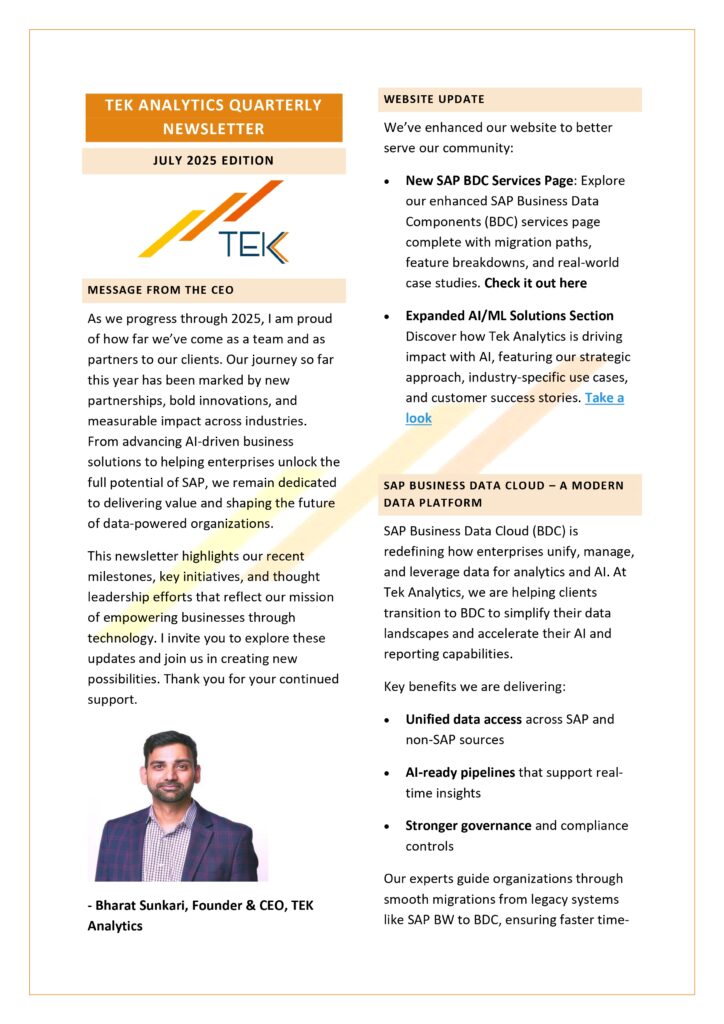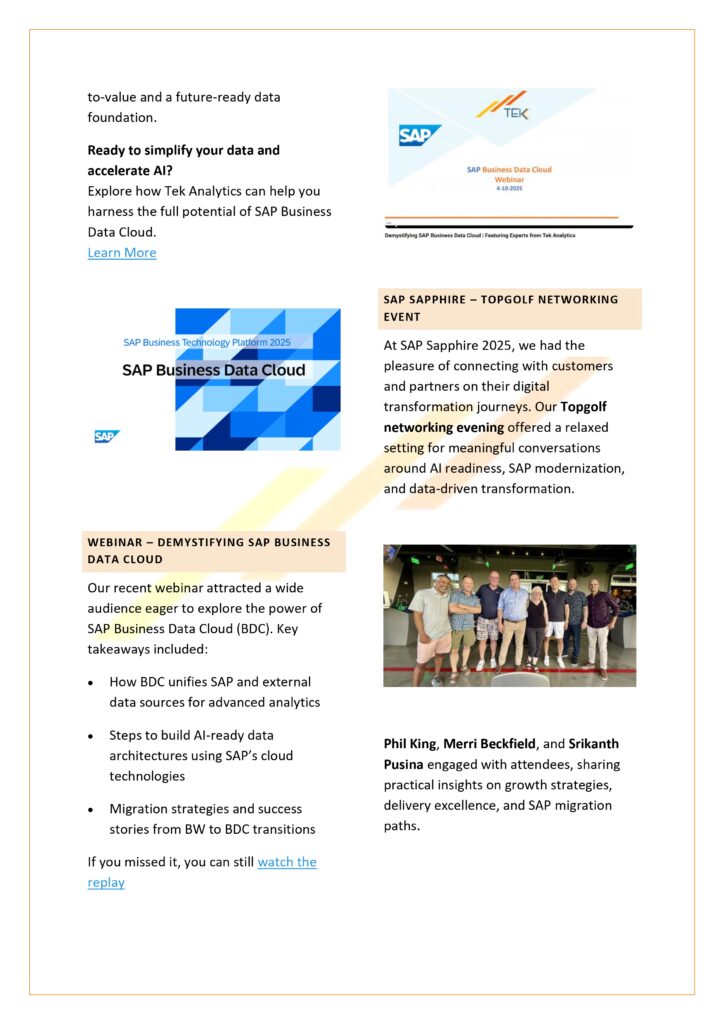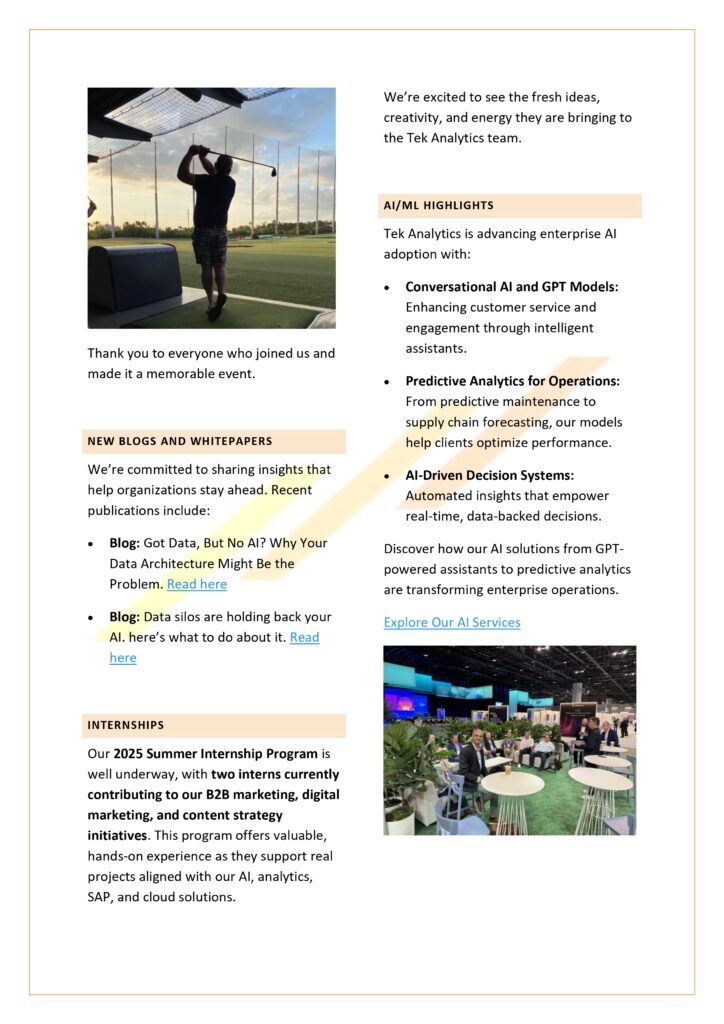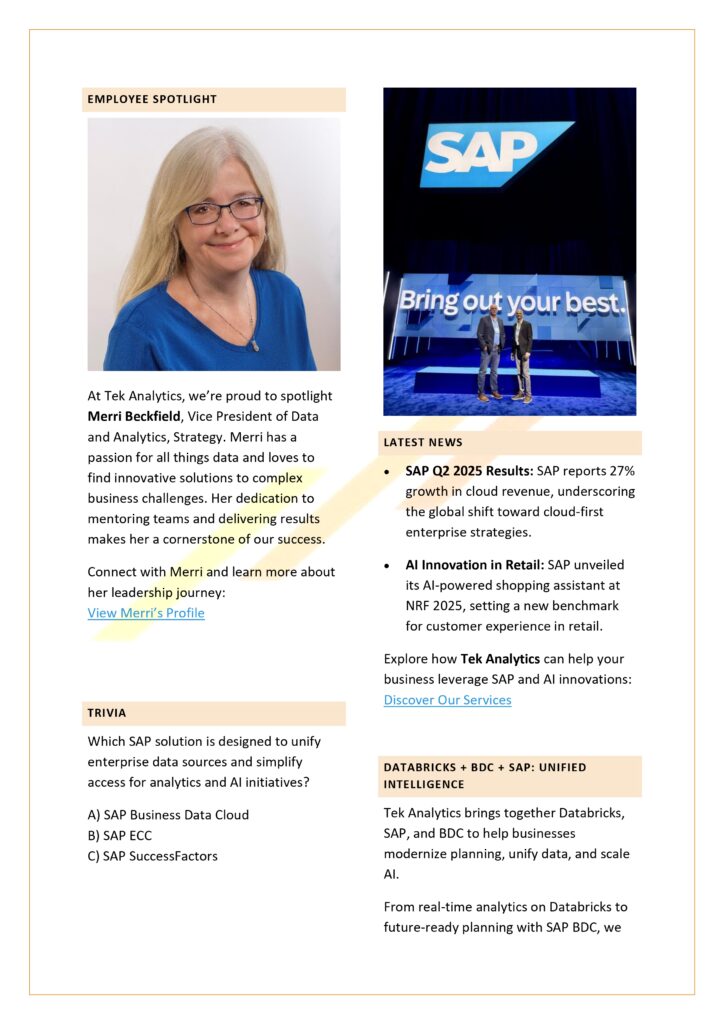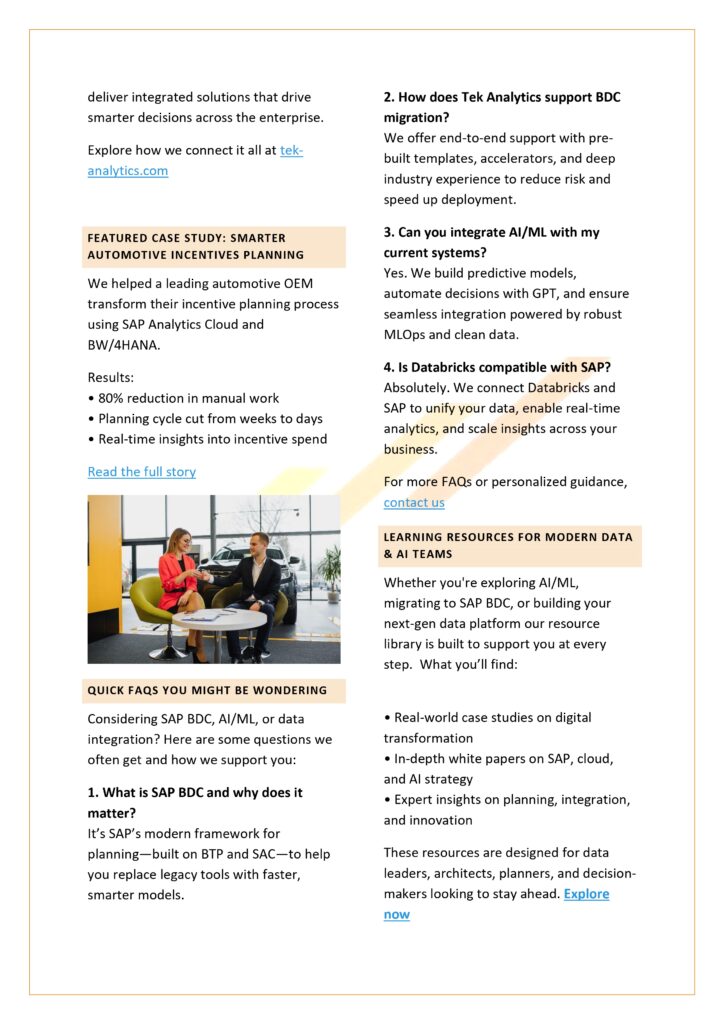A Key to AI Success: The Data Foundation
A Key to AI Success: The Data Foundation
AI success doesn’t start with algorithms. It starts with data.
In today’s competitive landscape, organizations are investing heavily in AI, yet many struggle to see real returns. Why? Because their data foundation isn’t ready. Clean, integrated, and accessible data is the backbone of every successful AI initiative.
This guide explores why building the right data foundation is essential for unlocking AI’s full potential. From overcoming silos to streamlining data pipelines, we’ll uncover the practical steps organizations need to take to turn data into actionable intelligence and drive meaningful outcomes with AI.
Let’s dive into how a strong data foundation becomes the true catalyst for AI success.
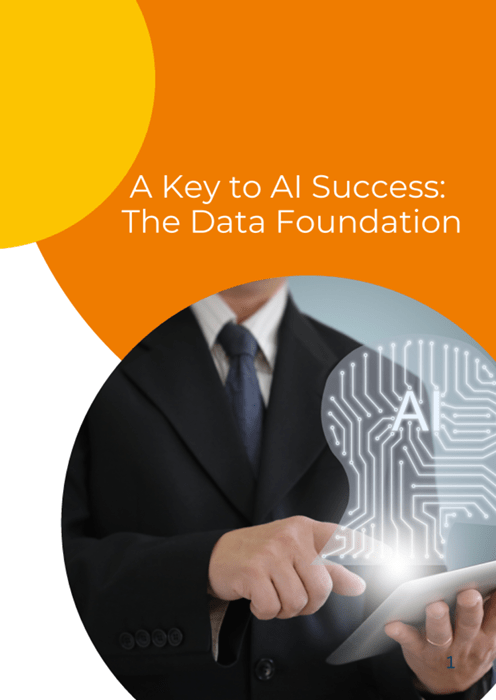
Please complete the form to access the whitepaper:
Enabling Business Friendly Semantics in Power BI from SAP Datasphere.
Enabling Business Friendly Semantics in Power BI from SAP Datasphere.
As a large commercial construction company, with a long history in North America, Barton Malow is committed to building People, Projects, and Communities. While Barton Malow has been in business for over 100 years, they are not resting comfortably with past processes. Rather, Barton Malow is on a mission to transform the construction industry through innovation and increased efficiency in the building process.
To that end, they are focused on leveraging data and having a data-driven culture to aid them in their mission. However, on the journey they encountered a bit of a road bump with SAP Datasphere and Power BI.
THE PROBLEM
To get started, here is a bit of background on the situation. The Barton Malow team was facing a significant challenge with the inability to automatically feed business metadata from SAP Datasphere into Power BI. In addition, Datasphere does not check for duplication of business names (only technical names are checked) and if duplicate business names are in the same source, the Power BI load failed.
This limitation necessitated the implementation of a manual process for gathering and loading data into Power BI daily. The workaround consisted of manually pulling the metadata into a JSON file then putting through a PBI rename step. This not only increased the risk of errors but also consumed valuable time and resources, hindering the company’s ability to leverage data-driven insights effectively and efficiently.
THE SOLUTION
To overcome these problems, the Tek team worked with them to thoroughly understand the current situation and design an automated solution to the issues. The solution leveraged the HANA cloud directly using Business Application Studio and modeling HDI container based calculated views, which were then accessed by Power BI. This approach enabled the retrieval of business names without manual intervention.
THE RESULTS
At the end of the day, the outcome was a solution that provided:
- Improved business process efficiency with the elimination of manual processes.
- Seamless availability of business names in Power BI to support self-service and data-driven culture.
Ready to move your data strategy forward and unlock the full potential of your data? This client success story is just one example of how we help businesses modernize their data architectures, streamline operations, and drive faster decision-making.
Let us help you achieve the same success! Contact us today to discuss how we can support your migration to SAP Datasphere. Contact TEK – Tek Digital Transformations
Demystifying SAP Business Data Cloud
Demystifying SAP Business Data Cloud
SAP Business Data Cloud (BDC) brings together data, analytics, and planning into one powerful platform.
It helps businesses make smarter decisions by unifying insights across SAP and non-SAP systems.
Request Recording
Streamlining Automotive Incentives Planning
By – Merri Beckfield
Streamlining Automotive Incentives Planning
Most car buyers likely aren’t aware of the work put into planning the incentives we often see advertised. That is, those special offers (such as cash back or an amazing 0% interest rate) encouraging each of us to purchase a new vehicle. The effort that car manufacturers put into this is quite significant. The number of variables that need to be considered to come up with an incentive offering that is competitive, cost effective, and drives sales is somewhat daunting. Factors beyond the forecast of demand, costs, and manufacturers margin such as the impact to the margin of the car dealer and varying market conditions by state create added complexity.
In collaboration with a large-scale automotive manufacturer, we tackled the challenge of streamlining the automotive incentive planning process. By implementing an end-to-end solution which leveraged predictive techniques, automation, and strong change management the team was able to streamline the process: reducing the duration from weeks to days and delivering an 80% reduction in manual interventions.
“Our planners love the new experience and we as a leadership team, we are thrilled with the improved speed to market.” – Director of FP&A
THE PROBLEM
Before diving in, it’s important to understand the challenges that were being faced by the manufacturer driving the need to do something. The supply chain was in a state of turmoil, and rising banking interest rates were significantly impacting auto incentives. Financial closing was a cumbersome and complicated process due to the intricacies of dealer contract terms and dealer stock. The organization was finding it nearly impossible to react to market conditions and adapt new promotions to the market without engaging in heavy manual labor. Incentive planning was a time-consuming and manual task, lacking the flexibility needed to keep up with the fast-paced market.
THE VISION
To improve the situation, the auto manufacturer clearly defined their vision and objectives. First, they wanted to tackle the entire incentives lifecycle, ensuring that the evolving incentives management systems could deliver meaningful business value across all system elements. A major focus was enabling granular geographic planning, allowing for more precise program design and targeted deployment. Specifically, the ability to plan targeted incentive offers down to the region or state level. Second, they wanted to streamline operations via automated program execution integrated with financial systems, which would lead to faster, more reliable incentive rollouts. This needed to include the ability to include considerations around dealer stock in the closing process. Finally, they sought to enhance post-mortem program performance analysis, enabling their brands to effectively balance volume and profit margins while achieving both brand and corporate sales objectives.
THE SOLUTION
To overcome the challenges, together the team came up with a strategy and plan to develop an end-to-end incentives life cycle planning application which considered all the key variables. The solution not only leveraged predictive analytics to create a granular plan by geography to the region/state level, but it also leveraged workflows, along with automation to streamline the planning process.
One key to success of the solution was leveraging SAP Analytics Cloud as the single enterprise planning tool. By providing end-to-end capabilities in a “one stop shop”, manual interventions were minimized. Planning duration was reduced from weeks to hours.
From a technical point of view, the technology powering the solution was SAP Analytics Cloud for the planning functions. Data harmonization was done in BW4HANA. To achieve, VIN level planning write back functionality to BW4HANA was leveraged.
From a business point of view, the following capabilities of the solution were transformative:
- Including dealer stock considerations in the financial close process.
- Having flexibility in managing dealer margins.
- Being able to plan and create targeted offers down to the state level.
THE RESULTS
With a remarkable 80% reduction in manual tasks, the team significantly minimized manual interventions, allowing planners to focus on more strategic initiatives. The application has enabled effective budget allocations and provided real-time spend visibility, which means users can make informed decisions more rapidly.
Users are enjoying an improved experience thanks to the seamless integration of sales, incentive, and financial planning, along with automated financial adjustments that streamlined processes. Collaborating with stakeholders to design effective workflows has paid off, as users now can analyze and plan incentive budgets much more efficiently.
Plus, reconciling incentives and optimizing programs has never been easier! The flexibility to add new planning models on-the-fly and personalized reporting options, complete with filters for models and even VINs, empower users to align plans across programs and measure their effectiveness.
Overall, this application has not only enhanced operational efficiency but also fostered a culture of collaboration and data-driven decision-making.
“The partnership between our organization, TEK and SAP, was incredible.
We were able to leverage SAP Analytics Cloud to modernize and automate a process that was broken and expensive.
….
TEK brought in the best-in-class experts with deep automotive industry experience and thought leadership”
Director Finance and Planning
If you are facing a similar planning challenge (regardless of industry), let us help you achieve the same success! Contact us today to discuss.
Contact TEK – Tek Digital Transformations
Got Data, but No AI? Why Your Data Architecture Might Be the Problem
Got Data, but No AI? Why Your Data Architecture Might Be the Problem
Are you facing this too?
It’s more common than you think.
A company kicks off an AI project.
The budget’s approved. The latest tools are in place. A smart, capable data team is ready to roll.
Everyone’s excited—AI will predict problems, streamline decisions, and cut costs.
But a few months in… things start to stall.
The ideas looked great on paper—but in practice? Nothing really works.
So, what went wrong?
It’s not the people.
It’s not the tools.
It’s not the money.
The real roadblock? The data.
It’s messy. Disconnected. Spread across silos.
And that makes it nearly impossible for AI to deliver real results.
Having Data Isn’t the Same as Using Data
These days, most companies have plenty of data. Sales records, customer details, machine logs, website clicks the list goes on. But here’s the problem: that data often lives in different systems. The sales team can’t easily see what the operations team has. The finance data is stored separately. Different formats, different rules, no easy way to connect it all.
So, when you try to use AI, it struggles. It either can’t find what it needs, or it ends up working with bad, confusing data. And that means the insights it produces don’t help the business move forward.
Why Your Data Structure Matters So Much
Think of your data like building blocks. If they don’t fit together properly, you can’t build anything strong no matter how advanced your AI tools are.
Here’s a simple comparison that shows what a weak setup looks like versus a strong one that’s ready for AI:
Weak Data Setup | Strong Data Setup |
Data stuck in silos, hard to combine | Data connected across teams and systems |
Outdated or messy data | Clean, consistent, high-quality data |
Slow, manual preparation | Automated data flows ready for AI |
Hard to get current info | Real-time data availability |
Risk of compliance issues | Strong governance and secure practices |
When your data is structured well, AI can deliver the insights, predictions, and automation you want.
The Hidden Costs of a Weak Data Setup
When companies don’t focus on fixing their data structure, they end up paying for it in other ways. Teams spend too much time just cleaning and organizing data instead of building AI models. The insights that come out of AI often aren’t useful because the data is messy. And delays pile up — months go by before the business sees any value from its AI efforts. All of this creates frustration across teams and wastes valuable time, energy, and budget.
What You Can Do
The good news is this can be fixed. The first step is to stop thinking of data as just an IT issue. Data is a core part of the business plan; it powers the decisions you want AI to help you make. That means planning your data setup with your AI goals in mind. Companies that succeed here often rethink how their data is connected, explore modern ways to manage and govern it, and make sure the data is accurate, safe, and up to date.
When the foundation is solid, AI can finally do what it’s supposed to help your business grow smarter, faster, and stronger.
The Big Takeaway
Having data is just the start.
If AI isn’t delivering the value you hoped for, take a closer look at how your data is structured. Fix that, and you’ll unlock the real power of AI.

